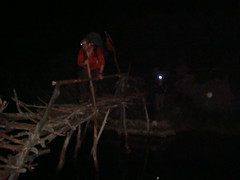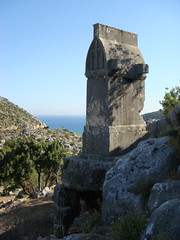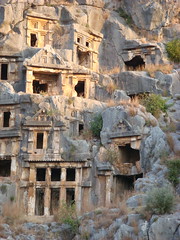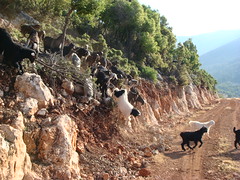We've just posted some new sets of photos to Flickr, including one on the Lycian Way walk in Turkey and one of young Edouard our weekend with Jean's family in Louvain-la-Neuve.
Should anyone be looking for a beautiful hike in a very hospitable climate and culture, the Lycian Way is exactly that. The trek turned out to be somewhat more physically demanding than we'd anticipated, but also extremely surprising and rewarding. We started the walk in Ucagiz, a sweet little coastal village, packed our rucksacks with fresh fish (only for the first 2 hours!), beer, and lots of oil-cured olives, then traced the coastline for the next two days, camping on the beaches and cliffs. It was just hot enough to be pretty taxing around midday, although it was always fresh and cool in the shade. Here we are, after having missed the mark of finishing our walk before nightfall, and finding our selves confronted by the path dead-ending at this ingenious structure:

On the third day we angled inland, via a very steep climb up to the ruins of a temple and oracle to Apollo. The following two days were almost entirely uphill climbing, into the Teke mountains above the town of Demre. The highest point was the peak of Incegeris at 1800 meters, which we reached at the end of the day on Monday.
All along the route were the remains of Lycian cities, acropoli (ises?), and tombs, looking much like what you'd see in other parts of the Hellenistic world from around 200 BC. The tombs were enormous, carved stone pieces, typically in saddle-like form like this:

At the ruins of the city of Myra, which we visited just at the beautiful hour of dawn, after a very uncomfortable and short night encamped in an orange orchard, there was an amazing stone theater, situated in front of a backdrop of classical greek tombs built into a sheer cliff wall:

As we ascended into the mountains above Demre, the landscape changed quite rapidly and surprisingly into something much more like what you'd find in, say, Switzerland, with dense pine forests, and vertiginous peaks enshrouded in mist. Our map showed named towns along our route here, but these turned out to be mere clusters of summer goat-herders' huts, without plumbing or electricity, much less shops and cafes. Although we'd anticipated being able to re-provision occasionally along this part of the way and could not do that, the shepherds and farmers continually showered us with more tomatoes, cucumbers, and tiny glasses of strong tea than we could possible consume. We tried to thank them in our newly acquired Turkish (teshekur edirim), but it was the universal appreciation of cigarettes that really allowed us to express our gratitude (thanks to Roly!).
Here, a near miss being crushed by a sudden avalanche of goats pouring off the mountainside:

Should anyone be looking for a beautiful hike in a very hospitable climate and culture, the Lycian Way is exactly that. The trek turned out to be somewhat more physically demanding than we'd anticipated, but also extremely surprising and rewarding. We started the walk in Ucagiz, a sweet little coastal village, packed our rucksacks with fresh fish (only for the first 2 hours!), beer, and lots of oil-cured olives, then traced the coastline for the next two days, camping on the beaches and cliffs. It was just hot enough to be pretty taxing around midday, although it was always fresh and cool in the shade. Here we are, after having missed the mark of finishing our walk before nightfall, and finding our selves confronted by the path dead-ending at this ingenious structure:

On the third day we angled inland, via a very steep climb up to the ruins of a temple and oracle to Apollo. The following two days were almost entirely uphill climbing, into the Teke mountains above the town of Demre. The highest point was the peak of Incegeris at 1800 meters, which we reached at the end of the day on Monday.
All along the route were the remains of Lycian cities, acropoli (ises?), and tombs, looking much like what you'd see in other parts of the Hellenistic world from around 200 BC. The tombs were enormous, carved stone pieces, typically in saddle-like form like this:

At the ruins of the city of Myra, which we visited just at the beautiful hour of dawn, after a very uncomfortable and short night encamped in an orange orchard, there was an amazing stone theater, situated in front of a backdrop of classical greek tombs built into a sheer cliff wall:

As we ascended into the mountains above Demre, the landscape changed quite rapidly and surprisingly into something much more like what you'd find in, say, Switzerland, with dense pine forests, and vertiginous peaks enshrouded in mist. Our map showed named towns along our route here, but these turned out to be mere clusters of summer goat-herders' huts, without plumbing or electricity, much less shops and cafes. Although we'd anticipated being able to re-provision occasionally along this part of the way and could not do that, the shepherds and farmers continually showered us with more tomatoes, cucumbers, and tiny glasses of strong tea than we could possible consume. We tried to thank them in our newly acquired Turkish (teshekur edirim), but it was the universal appreciation of cigarettes that really allowed us to express our gratitude (thanks to Roly!).
Here, a near miss being crushed by a sudden avalanche of goats pouring off the mountainside:


1 Comments:
Lizzie,
I really enjoyed reading about your travels. You seem to have odd adventures that belong in a book. You are the family's traveler I most admire. Deborah and I are planning on Greece for a honeymoon, one of the off the beaten path islands, and possibly Turkey. It will greatly depend on feasability, though. Any suggestions?
Post a Comment
<< Home